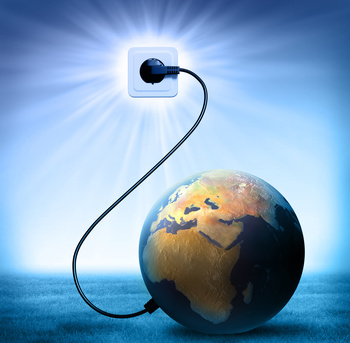Ohayoo Gozaimasu~ How is everyone's weekend? I know mine was a wetty one. I just went to Malacca in Malaysia last weekend (7th June 2015) and it was totally a "refreshing" experience. There was flash flood in that state due to raining non-stop from early morning till afternoon. I was planning to go for the local food but was stopped by the never-ever forgiving rain.
At least there's no one injured during this storm, which lasted till the afternoon. That's when the Sun had finally came out and so is my another post on energy efficiency, which we called it as Solar power.
What is Solar Power?
Our planet is part of a solar system, meaning it's rotating around the Sun. The Sun is used to dry clothes and grows food. But in the 19th century, Alexandre Edmond Becquerel discovered that certain materials produced small amounts of electric current when exposed to light. He discovers the photovoltaic effect while experimenting with an electrolytic cell made up of two metal electrodes placed in an electricity-conducting solution. The electricity-generation increased when exposed to light.
The sunlight is basically what we call a renewable energy source because it's always there, everyday. The solar power is actually converting the sunlight into electricity, using photovoltaic (PV). Some buildings use the solar thermal panel to heat water for washing or heating. The carbon footprint of solar PV is small because the materials used in PV panels are being recycled.

How does it help in energy saving?
Photovoltaic systems use no fuel and the modules typically last 25 to 40 years. The capital costs make up the great majority of the cost of solar power. Operations and maintenance costs for new utility-scale solar plants are estimated to be 9 percent of the cost of photovoltaic electricity, and 17 percent of the cost of solar thermal electricity.
Electricity costs vary by places. With such a broad range, it’s important to check the local rates of where you live to find what your real savings will be. For the most exact calculations, factor in an average increase of 4.3% each year on your power bill. With solar energy, you can all but drop this cost.
Pros & Cons
So now we all know that solar energy has many upsides in utilizing energy efficiently but how about the down side? There are a few of them which we could not ignore while evaluating either want to install the solar panel or using the conventional electricity supply by the power utility.
Feed-In Tariff & other government incentives
In the effort for reducing carbon footprint, many countries' governments have created various financial incentives to encourage the use of solar power, such as fee-in-tariff programs. Also, the Renewable portfolio standards impose a government mandate that utilities generate or acquire a certain percentage of renewable power regardless of increased energy procurement costs. Let's take Malaysia as an example.
Feed in Tariff (FIT) is a special tariff rate that TNB (Tenaga National Berhad-Power Utility) would buy electricity from the Solar PV owner. The FIT rate for 2013 is around 4x of TNB residential Tariff rate, this means TNB is buying at a 4x tariff rate compare to the tariff rate that they are selling. The FIT is governed by Sustainable Energy Development Authority Malaysia (SEDA).
You could engage a SEDA/ISPQ qualified Solar System Integrator or service provider to apply for the Feed in Tariff. The duration for the FIT would be 21 years. Basically TNB would sign a contract with the FIT rate with the Solar PV owner for 21 years. An additional PV meter (similiar to TNB meter) would be installed to record down the electricity generated by the Solar PV system. TNB would pay you based on the unit (kWH) generated multiply by the Feed in Tariff Rate.
The ROI (return of investment) roughly would be around 12%-17%. This is an estimation only and depends on the solar PV location, geographical condition, design, and many other factors. We would earn roughly around RM500-RM2000 passive income per month for typical house/shoplot Solar PV system.
Should we use Solar energy?
Above is a list of many solar energy pros and cons, and although not definitive, you can see how the number of pros relating to solar energy, greatly outweighs the cons of solar energy. You have known the basic of the solar energy design & application.
The main reason we are not seeing a large amount of solar energy technology installations is due to cost, and unfortunately, as the price of fossil fuels remains lower than the initial investment towards the currently available solar panels, we will not see a mass shift towards solar electricity production.

However, I believe that down the years, the materials of manufacturing solar panels will be getting cheaper and one day, all the buildings will be harnessing the energy of the Sun. The only question will be when that'll happen.
Passes une bonne journée~

No comments:
Post a Comment